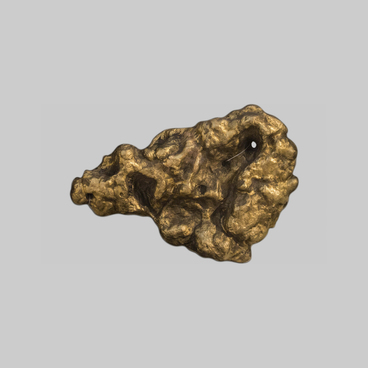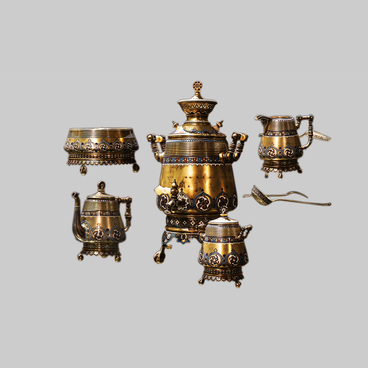In 2007, a burial of a 50-year-old woman was discovered during the excavation of burial mound No. 3 at the KichIgino burial ground (Uvelsky District, Chelyabinsk Region). The sleeves and top of her dress were embroidered with small beads, and the cuff of the right sleeve was also embroidered with leaves of thin gold foil. Both wrists were decorated with spiral-shaped bracelets, which were made of bronze and covered with gold foil, and with strands of cone- and spindle-shaped beads made of stone and glass. The ring finger of her right hand was adorned with a spiral-shaped ring made of round-section gold wire. Her left hand was probably replaced with a prosthesis made of organic material, with a similar ring on one of the fingers. The woman’s neck was adorned with a torc with zoomorphic ends: scientists believe that they depicted boars. The torc’s bronze base was wrapped in gold foil.
A mirror with a long side handle, decorated with an ornament of concentric circles, lay on the forearm of the deceased. It was stored in a decayed leather case, which also contained a human tooth and a piece of chalk. A small rock crystal lay next to the mirror. A small bronze pot on a conical base stood at the feet of the deceased.
It had a vertical handle on one side and a spout on the other. There were traces of carbon residue on the inside of the pot. Below her right hand lay a sharpening stone, iron knives, an awl, and a bone spoon.
The collection of beads includes pendants made in Indian and Iranian handicraft workshops. The beads made of white, brown, and black agate were probably manufactured on the territory of Achaemenid Iran.
The valuable grave goods and rare objects found inside the burial point at the high social standing of the deceased woman. She probably came from an aristocratic family that controlled a large forest steppe territory of the Southern Trans-Urals. Experts believe that the bronze pot was used to make herbal infusions. This suggests that the buried woman was a healer, or, as journalists argued, a priestess.
A mirror with a long side handle, decorated with an ornament of concentric circles, lay on the forearm of the deceased. It was stored in a decayed leather case, which also contained a human tooth and a piece of chalk. A small rock crystal lay next to the mirror. A small bronze pot on a conical base stood at the feet of the deceased.
It had a vertical handle on one side and a spout on the other. There were traces of carbon residue on the inside of the pot. Below her right hand lay a sharpening stone, iron knives, an awl, and a bone spoon.
The collection of beads includes pendants made in Indian and Iranian handicraft workshops. The beads made of white, brown, and black agate were probably manufactured on the territory of Achaemenid Iran.
The valuable grave goods and rare objects found inside the burial point at the high social standing of the deceased woman. She probably came from an aristocratic family that controlled a large forest steppe territory of the Southern Trans-Urals. Experts believe that the bronze pot was used to make herbal infusions. This suggests that the buried woman was a healer, or, as journalists argued, a priestess.



